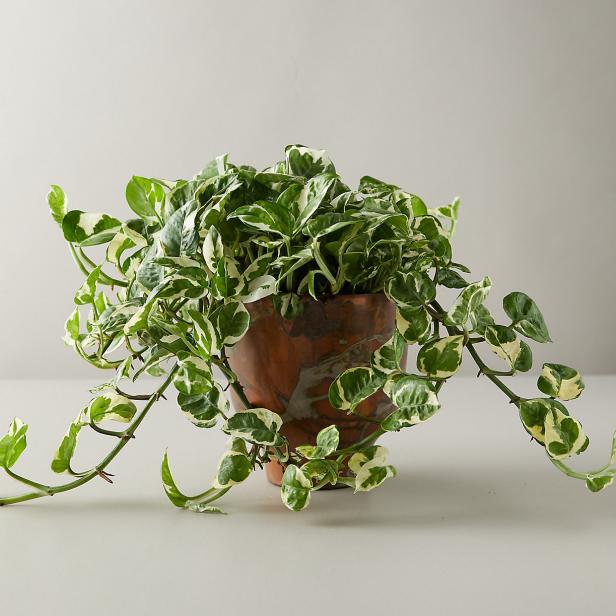This low-maintenance, creeping thyme indoor plant has heart-shaped leaves that can be confused with philodendrons. Pothos plants are an excellent houseplant for a new gardener since they are easy to care for and reproduce. But the real question is how to hang the pothos plant?
The “Devil’s Ivy” may not appear to be a pleasant plant to have around the house, but trust me: with heart-shaped leaves, exquisite trailing tendrils, and a tenacity that makes it one of the simplest house plants to grow inside, you will like your pothos. Here is this comprehensive guide, so you never have to worry about the devil being up with your pot plant again. It discusses basic needs, easy reproduction, low-effort pest management, and other pothos-growing information.
What Is a Pothos Plant?
Pothos (Epipremnum aureum) is a tropical plant endemic to French Polynesia that goes by several names, including devil’s ivy, money plant, and Ceylon creeper. In temperate climates, it is a popular houseplant. Its aerial root structure allows it to spread across woodland floors and ascend tree trunks in the wild. Pothos vines may develop up to 10 feet long inside.
Read More- Popular Dracaena Plant Types To Keep In Your Indoor Garden
4 Varieties of Pothos Vines
There are several pothos types, each with its own characteristic style of leaf variegation. The following are some of the most common pothos cultivars:
1. Golden pothos: This famous pothos has heart-shaped multicolored leaves rich green with yellowish gold speckles.
2. Marble Queen pothos: The Marble Queen pothos is a slow-growing pothos with creamy white streaks on gray-green foliage.
3. Neon pothos: This non-variegated pothos is well-known for its vivid chartreuse foliage. It’s an excellent plant for brightening up a dull spot in the home.
4. Pearls and Jade pothos: This plant has dark green foliage with vast patches of white variegation. It thrives in low-light environments.
Read More-What Are Some Good Creepers Plants Example?
How to hang Pothos on a wall?
You will need the following tools to hang vines on your home’s wall. While it is possible to turn the pothos without these tools, I find it simpler to have them on hand!
Here’s what you’ll require:
-3 Command Clear Mini Hook Packs (This is not a paid article; these are simply awesome)
-A vining plant (as previously indicated, pothos, or prayer plants (calathea) work well for this type of project.
Place your plant against a wall. Based on how you want your vines to appear, you may set them against a wall or hang them from a shelf or other hanging item. Keep in mind that the direction of your vines will be determined by where you place your plant–plants on the floor will have vines trailing UP the wall, while plants hanging above will have vines falling DOWN.
There is no such thing as a wrong location; just make sure you choose the best area for your vision. Now that you’ve determined your site grab your vines and begin deciding how you want to arrange them on your walls. Make a small pencil mark on the wall where you want each hook to go.
Once you’ve selected your targeted locations, follow the instructions in the package to install the command hooks. Remember to turn the “hook” outside so that it can fasten the vine rather than just leaving it to hang.
Read More- How To Grow String Of Dolphins Plant?
How to Hang Pothos?
Hanging pothos is an excellent technique to cultivate them inside.
Examine your plant first, trimming and untangling it if necessary.
Then, place it in your preferred hanging plant stand. The basket should be reinforced with solid links, rope, or cable to prevent your cherished plant from falling to the floor.
Arrange the vines to flow out of the container evenly from all sides. This will keep them ordered, preventing them from clumping with future development, and just looks nicer than a tangle of vines pouring out of one side. Then, when you hang your hanging planter, be sure you quickly water the plant to see whether it can withstand the weight of the plant, its soil, container, and water. If it can, you’re good to go.
BENEFITS
The most apparent advantage of pothos is their attractiveness, which instantly brightens up your indoor area with a waterfall of lovely foliage. That attractiveness, however, does not only help you aesthetically; keeping plants indoors makes you feel better. Caring for a home plant can increase serotonin levels in your brain and provides a sense of accomplishment.
Pothos can help you physiologically by cleaning the air in your home. According to NASA’s clean air study, pothos plants are among the most efficient air purifiers, eliminating dangerous chemicals from the air such as toluene, formaldehyde, carbon monoxide, and xylene. Toxins are taken through their leaves and roots, filtered out, and then released as oxygen. More oxygen in the air allows for body activities such as sleep and assists persons with respiratory difficulties. Pothos plants can also aid persons who suffer from respiratory problems by boosting the humidity in your house. Plants raise indoor humidity by releasing the bulk of the water you feed them into the air.
Soil and Water
Pothos plants do not need to be planted in soil; they thrive when placed in a container with water. If you put them in the ground, any potting mix will suffice. However, be mindful that a plant accustomed to just being in water may struggle to thrive in soil.
Pothos thrive when their soil is left to dry out in between waterings. As with any plant, look for health indicators in the leaves: if they’re shiny, bright, and cheery, the plant is happy; if they’re drooping or going brown, you’re not watering it enough. Yellow leaves indicate overwatering and root damage. Don’t keep the soil wet all the time.
Read More- 31 Best Plants For Rock Garden
Sum Up
Plant Maintenance
Pothos vines are notoriously tolerant of neglect, and with simple maintenance, they will thrive. Here are a few basic techniques to maintain your living wall looking its best:
• Allow the soil to dry between waterings. Water more if the leaves are dark and withering. If they’re yellow, use less water.
• Prune the leaves and stems regularly to help train the plant and keep the form of your living wall.
That’s all! You’re finished! It takes five minutes to transform your house into a pin-worthy plant fest. Direct the plant’s route with more hooks as it develops; just trim the vines when you’ve achieved peak forest.

















